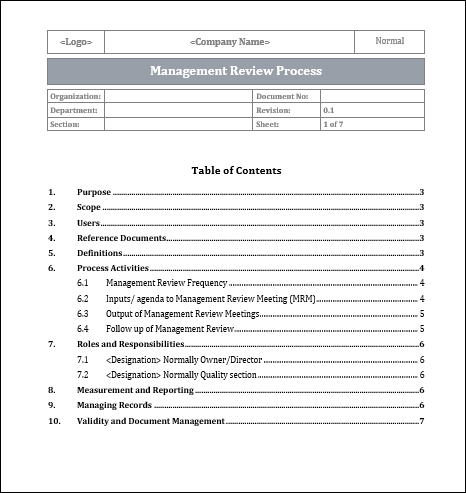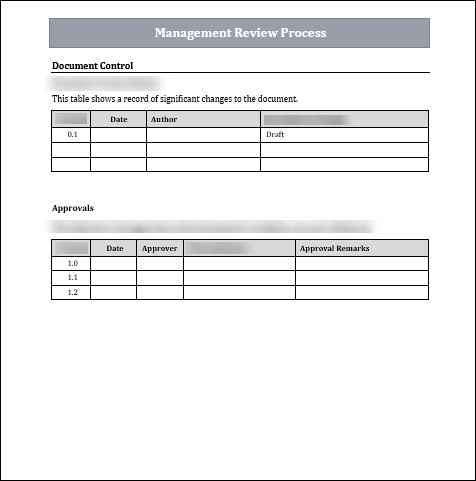ISO 9001 Management Review Process Template
The ISO 9001 Management Review Process Template is a valuable tool for organizations seeking to implement or improve their quality management system. The template provides a structured and systematic approach to conducting management reviews, which are an essential part of the ISO 9001 standard. This process allows management to assess the performance of the quality management system, identify areas for improvement, and make informed decisions about the organization's quality objectives and policies. By using the template, organizations can ensure that their management reviews are thorough, consistent, and effective in driving continuous improvement.

The Importance Of The ISO 9001 Management Review Process Template
1. Structured Review For QMS Effectiveness: Provides a structured and formal process for reviewing the effectiveness of the Quality Management System (QMS). This helps ensure that the QMS continues to meet the needs of the organization and its customers.
Enhances communication and coordination between top management and other stakeholders involved in the QMS. The review process template provides a framework for discussing and addressing any concerns or issues related to the QMS.
Facilitates the identification of opportunities for improvement. Through the review process, top management can identify areas where the QMS can be enhanced or where corrective actions need to be taken.
Supports the identification of potential risks that could affect the QMS. The review process helps in assessing the impact of external or internal changes on the effectiveness of the QMS and enables proactive risk management.
Ensures compliance with ISO 9001 requirements. The review process template helps organizations adhere to the ISO 9001 standard by ensuring that top management systematically reviews the QMS and takes necessary actions to maintain its effectiveness.
Provides a platform for strategic decision-making. The management review process template allows top management to evaluate the overall performance of the organization, set quality objectives, and align them with business goals.
Supports the establishment of a culture of continual improvement. The review process template encourages organizations to continually assess the effectiveness of their QMS and take proactive steps towards improvement.
Enhances customer satisfaction. By reviewing the QMS, top management can identify areas where customer requirements are not fully met and take corrective actions to enhance customer satisfaction.
Improves accountability and responsibility. The review process template ensures that top management takes ownership of the QMS and its performance, and provides a platform for discussing and addressing accountability and responsibilities within the organization.
Demonstrates commitment to quality. Regularly conducting management reviews using the template shows stakeholders, including employees, customers, and regulatory bodies, that the organization is committed to maintaining a high level of quality in its products or services.
Key Elements of an ISO 9001 Management Review Process Template
- Purpose and scope: The template should clearly define the purpose and scope of the management review process. This includes stating its objectives and how it fits into the overall quality management system.
- Agenda: The template should provide a structured agenda for the management review meeting. This should include specific topics to be discussed, such as the review of quality objectives, audit findings, customer feedback, and management system performance.
- Participants: The template should indicate who should participate in the management review meeting. This typically includes top management, quality managers, and other relevant personnel who can provide input and contribute to the decision-making process.
- Inputs: The template should specify the required inputs for the management review. This may include quality metrics, customer complaints, non-conformities, internal and external audit reports, and any other relevant information that can help evaluate the effectiveness of the quality management system.
- Outputs: The template should outline the expected outputs or outcomes of the management review process. This could include decisions on improvement actions, changes in quality objectives, resource allocation, and any additional actions needed to enhance the effectiveness of the management system.
- Review frequency: The template should establish the frequency of the management review meetings. This could be determined by the organization's needs and industry requirements. Quarterly or bi-annual reviews are common, but organizations may choose a different frequency based on their specific circumstances.
- Review criteria: The template should define the criteria against which the management review will be conducted. This could include compliance with ISO 9001 requirements, achievement of quality objectives, customer satisfaction, and any other relevant criteria that help evaluate the effectiveness of the quality management system.
- Follow-up actions: The template should require the identification and assignment of follow-up actions resulting from the management review. This ensures that decisions made during the meeting are translated into concrete actions and responsibilities are clearly assigned.
- Review record: The template should specify the documentation requirements for the management review process. This includes keeping records of meeting minutes, decisions made, actions assigned, and any other relevant information. These records serve as evidence of the organization's commitment to continual improvement and compliance with ISO 9001 requirements.
- Evaluation and improvement: Lastly, the template should emphasize the importance of evaluating the effectiveness of the management review process itself. This could include conducting periodic reviews of the template, seeking feedback from participants, and making improvements as necessary to ensure the process remains efficient and effective.

Benefits of ISO 9001 Management Review Process Template
- Standardized process: The use of an ISO 9001 Management Review Process Template ensures that the management review process is standardized and consistent across the organization. This allows for easier understanding and implementation of the process by employees.
- Increased efficiency: By using a template, the management team can save time and effort in creating a management review process from scratch. The template provides a structured framework that can be customized to suit the organization's specific needs, allowing for a more efficient and streamlined review process.
- Improved decision-making: The management review process template helps in collecting and organizing relevant data and information essential for decision-making. This enables the management team to have a comprehensive understanding of the organization's performance, identify areas for improvement, and make informed decisions based on objective data.
- Enhanced accountability: The template helps in assigning roles, responsibilities, and timelines for each step of the management review process. This ensures that all key stakeholders are held accountable for their respective tasks and deadlines, promoting a culture of responsibility and ownership within the organization.
- Continuous improvement: The management review process template facilitates the identification of areas for improvement and the implementation of corrective actions. By regularly reviewing and analyzing organizational performance, the management team can identify gaps, address non-conformities, and implement preventive measures to continually improve the effectiveness and efficiency of the organization's processes.
- Compliance with ISO 9001 requirements: ISO 9001 certification requires organizations to have a documented management review process. The use of a template ensures that the process meets the requirements of ISO 9001 and helps in demonstrating compliance during audits.
- Facilitation of communication and collaboration: The template serves as a communication tool, providing a common language and structure for discussions during the management review process. This encourages collaboration and facilitates effective communication among the management team, fostering a shared understanding of organizational goals, challenges, and opportunities.
- Documentation and record-keeping: The template allows for the documentation and recording of important discussions, decisions, and actions taken during the management review process. This ensures that all relevant information is captured and retained for future reference, audits, and continuous improvement purposes.
Conclusion
In conclusion, the ISO 9001 Management Review Process Template provides organizations with a structured approach to effectively evaluate and improve their quality management system. By conducting regular management reviews, organizations can identify areas for improvement, address any non-conformances, and make informed decisions to enhance customer satisfaction and overall business performance. This template serves as a valuable tool in streamlining the review process, ensuring that all necessary aspects are covered, and allowing the organization to maintain compliance with ISO 9001 standards. By implementing this template, organizations can strengthen their quality management practices, drive continuous improvement, and ultimately achieve sustainable success in their industry.

